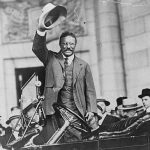
Theodore Roosevelt
Over the holidays, I re-read Doris Kearns Goodwin’s The Bully Pulpit, a superb study of the Progressive Era and the administrations of Presidents Theodore Roosevelt and William Howard Taft. According to Goodwin, Roosevelt coined the term “bully pulpit” to describe “the national platform the presidency provides to shape public sentiment and mobilize action.” Roosevelt made full use of the pulpit his presidency provided, including his remarkable nine-week transcontinental train trip covering 14,000 miles across 24 states and territories in 1903. Focusing on a small number of issues he passionately embraced, including corporate trusts, the tariff, and environmental protection, Roosevelt delivered 265 speeches during his amazing odyssey. Enthusiastically reaching out to his fellow citizens proved well worth the huge expenditure of time and energy, witness the impressive accomplishments of Roosevelt’s second term.
Some of my readers might be tempted to think of the bully pulpit as the exclusive preserve of our nation’s chief executive, but experience has taught that it can be a powerful tool at the local level. Mounting the bully pulpit has proved to be a wise investment of time and energy for chief executives of organizations that are heavily dependent on wide public understanding and tax support. Of course, public school districts and transportation authorities come immediately to mind. Large and highly complex (both operationally and financially) public enterprises, they not only defy easy understanding, their image has also taken a real beating in this era of widespread and growing skepticism of public institutions.
Over the past quarter-century I’ve worked with a number of school superintendents and transit CEOs who have made highly effective use of the bully pulpit to build public support for tax issues their boards have put on the ballot. Four preeminent factors appear to account for their success at the podium:
- They treat their bully pulpit as a top chief executive priority worth serious time and attention, rather than seeing it as an occasional diversion. It’s right up there with such critical CEO functions as working with the board and leading large-scale innovation.
- They take a highly proactive approach, identifying high-stakes forums and engineering speaking engagements, rather than merely reacting to invitations on an ad hoc basis.
- They develop specific talking points for a core set of topics, such as how their school district is financed and the bottom line benefits their transit services generate for the community, and they continuously update and refine these talking points.
- And recognizing that content, although important, can’t alone carry the day with skeptical audiences, they pay close attention to developing and refining their speaking skills and always welcome feedback from audience members.





